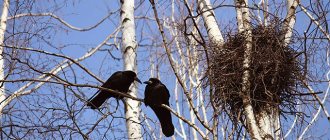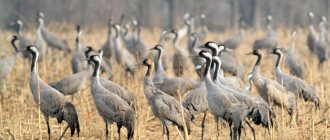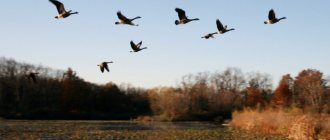For most people, the word “nightingale” is associated with the idea of the best feathered singer. The nightingale is one of our most common songbirds. All its feathers are colored a uniform brown color, which is lighter on the abdomen and turns white. Large dark eyes give a special charm to the nightingale.
Feeding only on insects, the nightingale flies to warm countries for the winter. In spring, nightingales fly to their homeland at a time when trees and shrubs begin to put on leaves. Having returned home, the nightingales find their old homes and begin to sing. The nightingale usually sings both during the day and at night. The nightly singing of a nightingale makes an incomparably greater impression on listeners. In order to listen to the night concert of this singer, many people specially go for walks in the forest in the evening.
The nightingale's singing is called beautiful, but not all males deserve such an assessment. There are true vocal masters among them, but there are (quite often) very weak performers. The fact is that high song skill is not an innate property of males: young birds acquire it only if their fathers or neighbors are able to teach them this.
Why do male nightingales sing?
Nightingales are considered the king of songbirds. Only male nightingales sing, because with their song they attract a female and inform all other rivals who this territory belongs to.
Interesting materials:
Which animals are clean and unclean? What animals can change sex throughout their lives? What animals can you have in your apartment? What animals are considered pets? What animals live in the Caspian Sea? What sounds does the cuckoo make? What should an eclair be like? What color should the wallpaper be in a room whose windows face north? What should a towel be like for a newborn? What kind of smoke do they fumigate bees with?
Description of the nightingale
The song of a nightingale heard once will forever remain in the heart and memory. Many romantic events are associated with these birds. This is most likely due to their innate tendency to attract females with their whistles. After all, it is the “single” males who do not have a mate who sing immediately upon returning from warm regions to attract future lovers. Who would have thought that birds could be so romantic?
The nightingale cannot be considered a migratory bird 100%. The fact is that the inhabitants of northern latitudes actually fly to warmer climes for the winter. Residents of the southern part of the planet remain in their territories all year round.
The nightingale is considered a nocturnal bird. They sing their songs for days on end, only occasionally breaking off to feed. They received the title of nightlings because many lovers of nightingales sing in the thickets at night. Because at this time of day their vocals are heard best, because they are not disturbed by extraneous sounds from the surrounding world. At these moments, the famous “vocalists” sing louder and louder. Therefore, night is the best time for those who want to enjoy their singing.
But the songs of the nightingale can also be heard at dawn. Notes and modulations take on different forms depending on the purpose of singing and external circumstances. For example, in case of danger, his screams become similar to the croaking of a toad.
Appearance
It has long been believed that such a skilled singer should have the same beautiful plumage and fancy coloring. However, the nightingale looks quite ordinary. He looks more like an ordinary sparrow than a unique bird with such a wonderful voice.
The nightingale has vague gray markings on the chest, like the song thrush, and a duller upperparts.
The nightingale, like the sparrow, has small black lively eyes, a thin beak, and gray and brown plumage. He even has the same sharp reddish tail. But unlike the sparrow, which scurries around, the nightingale hides from human eyes. Seeing him live with your own eyes is a great success. Fortunately, this rarity is compensated by the huge number of photos of the “singer” on the Internet.
Also, if you look closely, the nightingale has slightly larger legs and eyes. The body plumage has a reddish-olive tint; the feathers on the chest and neck of the bird are brighter, so much so that you can even see individual feathers.
Types of nightingales
Rubythroat Nightingale
Nightingales are divided into two types: common and southern. Common ones prefer the lands of Siberia and Europe for nesting. Unlike its relative, the common nightingale is limited to lowlands and avoids dry areas. Southern representatives of the species settle closer to warm southern regions.
Both birds settle in the forest near water, and they are very similar in appearance. Their voices are difficult to distinguish, but the song of the southern nightingale is more universal, containing fewer harsh sounds, but weaker than that of its relative.
The western common representative has a lighter belly than that of its relative. There are also nightingales, which live mostly in Transcaucasia and Asia. But they sing much worse than the above representatives.
Character and lifestyle
Unlike most birds, they are antisocial and prefer solitude. An ideal habitat for a nightingale should include dense forests or woodlands. Large thickets and plenty of sunlight are ideal conditions for the nightingale bird. They prefer to be away from populated areas. Nightingales are migratory birds that can travel any distance in search of ideal climatic and territorial conditions.
The quiet version of the song is intended for a specific female, during the immediate period of courtship.
Their song changes depending on the season and circumstances. They are the most vocally gifted representatives of the avian world. Male nightingales sing loudest at night in late spring, when they return from wintering. They do this in order to attract a female and announce to all relatives that this territory is now his. During the day, his songs are less varied and delivered to the audience in shorter bursts.
Nightingale is a migratory bird
Nightingales belong to the order Passeriformes . These are migratory birds that fly towards North Africa for the winter. They return to us in the spring. The very first - by mid-April, most of them - after the appearance of insects, when young leaves begin to bloom on trees and bushes. Nightingales settle on the edges of forests, in thickets of bushes along river banks, in parks and gardens.
In spring, other birds also sing: robins (robins) and finches . Sometimes their ringing melodic trills are confused with the songs of nightingales.
The weight of the nightingale is about 25 g. The common (eastern) nightingale is larger and darker than the southern (western) . The color of the plumage is brownish-gray, slightly brighter on the throat and chest. The abdomen (especially in young birds) is variegated. The eyes are large and dark. The straight tail may be rounded at the end. If the nightingale is sitting, it often lifts it up and down. The nightingale jumps along the ground, twitching its tail and bowing.
In most of Russia (including the south of Western Siberia) and in Eastern Europe, they hear the characteristic ringing singing of the common (eastern) nightingale , which is distinguished by a sharp change in rhythm, rolling sound, whistles, trills and clicks.
In the European part of Russia (western and southern) there is a southern (western) nightingale . It is lighter than the common (eastern) nightingale. In flight, this bird is distinguished by its rufous rump and tail. The singing is sonorous. A long, sonorous song can have more than ten beats.
There are other types of nightingale. The ruby-throated nightingale, with a bright red throat on the male, lives in Siberia and the Far East This species in Russia nests in the Urals, on the coasts of the Sea of Okhotsk and the Sea of Japan.
The blue nightingale is smaller than a sparrow, its song is a loud trill. The species is found from the Ob basin to the coast of the Sea of Okhotsk and the Sea of Japan.
The whistling nightingale is characterized by a short whistle trill. Its habitat in Russia is the southern part of Siberia, the territory up to Sakhalin and Kamchatka.
Nightingales feed mainly on insects. They eat with pleasure and peck at bugs and spiders. The diet includes ants and worms. From the end of summer they can taste berries and fruits.
How long does a nightingale live?
In the wild, nightingales live from 3 to 4 years. In captivity, in a home environment with fairly good care, these birds live up to 7 years.
When do the birds stop singing?
Calendar: On June 29, birds stop singing, and the Spaniards fight with wine. On June 29, Orthodox Christians honor St. Tikhon. … On this day, songbirds stop singing, and only the nightingale will sing until Peter’s Day (July 12).
Interesting materials:
How to water violets for abundant flowering? How to water geraniums for abundant flowering? How to water indoor flowers to make them bloom? What did Polozova owe to Kirsanov? How to glue granite tiles to concrete? How to pierce ears? What should I impregnate the fabric with to keep its shape? What made B. Rastrelli famous? What made Fyodor Ivanovich Chaliapin famous? How is Quality Assurance different from testing?
How does the black-headed goldfinch sing?
The song is lively and beautiful - a quick set of various chirps and trills, crackles, among which at times the same calls can be heard, as well as nasal “tsiii”, “tsiee”. When singing, the male sits on a tree, bush or tall weeds. They sing from February–March until August, and occasionally until late autumn.
Interesting materials:
What is a numeral name examples? What is a range name in Excel? What is a domain name in email? What is a short adjective? What is morphological analysis of an adjective? What is the gender of adjectives? What is the gender of nouns? What's in the name Oksana? What kind of name is Gennady? What kind of name is Kirill?
Nightingale diet
Like many other birds, the nightingale's diet consists of fruits, plants, seeds and nuts. When food is scarce, they may turn to insects. This happens especially often during the breeding season. At this time, their menu consists of all kinds of insects and invertebrates. Layers of fallen leaves are a favorite hunting spot for the nightingale. There he looks for ants, maggots and beetles. If there are none, it eats caterpillars, spiders and earthworms.
The nightingale can attack prey by flying from low branches, or get food from the bark while sitting on a tree. On rare occasions, it catches in the air and eats winged insects such as moths and small butterflies.
At the end of summer, the bird adds berries to the menu. Autumn brings many new feeding opportunities and the nightingale sets out in search of wild cherries, elderberries, sloe and currants.
In captivity, they are fed mealworms, maggots, grated carrots, or ready-made mixtures developed specifically for insectivorous birds. Although, taming a nightingale at home, unfortunately, is very rare. Seeing him is a matter of great luck, not to mention catching and taming him.
Taming a wild nightingale requires remarkable endurance, self-control and tenderness. Closed in captivity, he can beat his whole body against the bars of his cage for days on end until he weakens or disappears altogether. Until the 19th century, domesticated nightingales in Russian provinces were considered a fashionable curiosity, which is why they almost found themselves on the verge of extinction.
Who is bigger, the nightingale or the sparrow?
Luscinia Luscinia) is a songbird with very nondescript plumage. ... The size of a nightingale
slightly
larger than a sparrow
, weighs about 25 grams, body length – up to 20 cm.
Interesting materials:
Where is the nucleus located in a cell? Where is the icon of the Iveron Mother of God located in Russia? Where is the source of the Yana River? Where are the southern and northern hemispheres? Where is the Patriarchate of Constantinople located? Where is the Izmail fortress located? Where is the Wormhole? Where is the little bear? Where is the continental crust located? Where is Matrona of Moscow?
Nutrition
At night the nightingale trills, and during the day it looks for food.
. He rakes the leaves on the ground, takes out bugs, worms, caterpillars and other living creatures. The nightingale can even catch prey on the fly; it has enough dexterity for this. In the summer, various ripe berries and fruits appear in the nightingale's diet, and it is especially partial to elderberry. Closer to autumn, he begins to stock up on fat, since he has a long flight to winter.
The nightingale brings great benefits to nature, as it saves plants from death. Its menu consists mainly of insect pests that destroy trees by eating bark and leaves.
Range, habitats
The nightingale, due to its wide distribution in England, is considered an English bird. These singers are a common sight in forests, parks and playgrounds. Nightingales are also found in other countries such as Portugal, Spain, Persia, Arabia, Austria, Hungary and Africa. Breeds in Europe, North-West Africa, the Balkans and south-west Central Asia; Winter in sub-Saharan Africa, from West Africa to Uganda. This singing bird is the national symbol of Iran.
The nightingale prefers low areas tangled with thickets of deciduous forests . Thickets of bushes and all kinds of hedges are a suitable place of residence for the nightingale. But to a greater extent, the nightingale is a low-lying bird.
Nightingales inhabit many areas near rivers or swimming pools, although they can also live on dry hillsides, in low bushes among coastal sand dunes. When singing during the day, the nightingale often changes its location, but night songs are usually staged from the same positions. He sings in two three-hour arias at night. The first aria ends around midnight, and the second begins early in the morning.
Reproduction and offspring
The nightingale flies from warm regions and immediately sets off in search of a mate. What is especially interesting is that it returns a few days before the buds bloom on the trees. It takes a couple of days to acclimatize. After this, the nightingale’s singing looks especially enchanting, because it goes in unison with nature itself, reviving from its winter sleep.
And so, in order to inform the females and other individuals about his own presence at the nesting site, the male nightingale spreads his wings to the sides and begins to sing loudly and loudly. This is where attempts to attract the attention of a potential lover begin.
The male lowers the volume of his singing as soon as the female flies closer. Then it displays its sounds at close range, fanning its tail and fluttering its wings excitedly.
After this, as a rule, mating occurs. Then, the female begins to build a family nest . She collects fallen leaves and coarse grass to establish a bowl-shaped base among the vegetation close to, or on the surface of, the ground. The male does not participate in the arrangement of the nest. The same as in hatching eggs with chicks. At this time, the nightingale sings loudly. As soon as the chicks hatch, he becomes silent. In this way, the nightingale tries not to reveal to predators the location of the nest with the babies.
The mother of the chicks keeps her home perfectly clean, regularly cleaning it of the babies' feces. The wide open orange mouths of the chicks encourage both parents to search for food for them. The loudest chick is fed first.
The babies are fed by their parents for 14 days. After this time, the young nightingales reach the required size to leave the nest. The nightingale chooses a new partner every year, often returning to its previous location.











